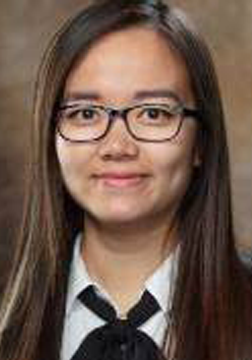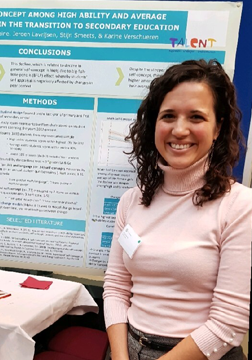2022-2023 Awards for Excellence in Research winners
Senior Division

Jonathan Wai and Joni M. Lakin, “Spatially Gifted, Academically Inconvenienced: Spatially Talented Students Experience Less Academic Engagement and More Behavioural Issues Than Other Talented Students”
Abstract: Spatially talented students have a capacity for success that is too often overlooked by educational services. Because these students may lack appropriate challenge, theorists suggest these students experience greater academic struggles than other gifted students, including [behavioral] problems and lack of academic engagement. The goal of this research was to explore empirical evidence for the claim that spatially talented students would experience more academic struggles than other gifted students. We sought to understand the size of the “spatially talented” population and their patterns of [behavioral] and academic struggles in high school. We also looked at long-term outcomes, including degree completion. This article explores characteristics of spatial talent in three U.S. nationally representative data sets: Project Talent (1960), High School and Beyond (1980), and the National Longitudinal Study of Youth (1997). Combined, these data provide a 60-year longitudinal study of student outcomes. This study utilized factor analysis, analysis of variance, and regression methods to explore the research questions for each data set. From our analyses, we estimate that 4-6% (at least 2 million) of the 56.6 million students in the U.S. K-12 system are spatially talented students who are not identified by common gifted and talented screening processes. These students had greater academic challenges, including reading difficulties, poor study habits, and [behavioral] troubles. We also found that spatially talented students were less likely to complete college degrees compared to other talented students. Our findings support the need for greater services to these talented students.

Michael S. Matthews and Jennifer L. Jolly, “Why Hasn’t the Gifted Label Caught Up With Science?”
Abstract: The development of both special education and gifted education as fields of study were closely tied to the origins of intelligence testing in the early 20th century. While special education’s terminology has become more nuanced and circumspect over the ensuing century, the term gifted has remained unchanged despite coming under substantial criticism in recent decades for its lack of specificity and for the innateness that the term implies as the primary cause of individual differences in ability. We examine this history and the seminal nationally disseminated reports related to gifted education, from the Marland report to the present, to consider why the gifted label has persisted. We conclude with some suggestions for how these issues might be remedied.

Saiying Steenbergen-Hu, “The Effectiveness of Current Interventions to Reverse the Underachievement of Gifted Students: Findings of a Meta Analysis and Systematic Review” (co-authors Paula Olszewski-Kubilius and Eric Calvert)
Abstract: Underachievement of gifted students has been a great concern for the field of gifted education. The current study reviewed 14 recent empirical studies concerning the effectiveness of underachievement interventions on gifted students’ achievement outcomes and psychosocial outcomes. Overall, there was no evidence that underachievement interventions significantly improved academic performance of gifted underachievers (g = .09, p = .387), especially in terms of course grades. Gifted underachievers receiving interventions significantly outscored their comparison peers on psychosocial outcomes (g = 0.22, p = .001), which consisted of a variety of measures on self-efficacy, goal valuation, environmental perceptions, self-regulation/motivation, and psychosocial functioning. Qualitative studies generally reported that gifted underachievers benefited from the interventions in terms of increased motivation for learning, improved self-regulation, and finding school more meaningful. Findings need to be viewed in light of the relatively low quality of the evidence from recent research on underachievement interventions.
Junior Division

Matt Brown, “Can You Ever Be Too Smart for Your Own Good? Comparing Linear and Nonlinear Effects of Cognitive Ability on Life Outcomes” (co-authors Jonathan Wai and Christopher F. Chabris)
Abstract: Despite a long-standing expert consensus about the importance of cognitive ability for life outcomes, contrary views continue to proliferate in scholarly and popular literature. This divergence of beliefs presents an obstacle for evidencebased policymaking and decision-making in a variety of settings. One commonly held idea is that greater cognitive ability does not matter or is actually harmful beyond a certain point (sometimes stated as > 100 or 120 IQ points). We empirically tested these notions using data from four longitudinal, representative cohort studies comprising 48,558 participants in the United States and United Kingdom from 1957 to the present. We found that ability measured in youth has a positive association with most occupational, educational, health, and social outcomes later in life. Most effects were characterized by a moderate to strong linear trend or a practically null effect (mean R2 range = .002–.256). Nearly all nonlinear effects were practically insignificant in magnitude (mean incremental R2 = .001) or were not replicated across cohorts or survey waves. We found no support for any downside to higher ability and no evidence for a threshold beyond which greater scores cease to be beneficial. Thus, greater cognitive ability is generally advantageous — and virtually never detrimental.

Bich Thi Ngoc Tran, M.A., “Expanding Gifted Identification to Capture Academically Advanced, Low-Income, or Other Disadvantaged Students: The Case of Arkansas” (co-authors Jonathan Wai, Ph.D.; Sarah McKenzie, Ph.D.; Jonathan Mills, Ph.D.; and Dustin Seaton, M.Ed.)
Abstract: We examined the state of Arkansas, empirically testing how focusing on high-achieving students using state tests might expand the pool of gifted identified students. From a broader sample of 173,133 students, we compared the degree to which students who were academically talented in the top 5% on third-grade state literacy and math assessments were identified as gifted in Arkansas. Across five independent cohorts, we replicated the finding that roughly 30% of the students in the top 5% on both thirdgrade literacy and math were not identified as gifted. Logistic regression (N = 3,992) indicated that high-achieving students participating in the federal Free/Reduced Lunch program were 50% less likely to be identified. These findings suggest that using state math and literacy assessments as universal screening tools could improve gifted identification of high-achieving students, many from low-income or other disadvantaged backgrounds.

Valentin Emslander, “The Relation Between Executive Functions and Math Intelligence in Preschool Children: A Systematic Review and Meta-Analysis” (co-author Ronny Scherer)
Abstract: Executive functions (EFs) are key skills underlying other cognitive skills that are relevant to learning and everyday life. Although a plethora of evidence suggests a positive relation between the three EF subdimensions, inhibition, shifting, and updating, and math skills for schoolchildren and adults, the findings on the magnitude of and possible variations in this relation are inconclusive for preschool children and several narrow math skills (i.e., math intelligence). Therefore, the present meta-analysis aimed to (a) synthesize the relation between EFs and math intelligence (an aggregate of math skills) in preschool children; (b) examine which study, sample, and measurement characteristics moderate this relation; and (c) test the joint effects of EFs on math intelligence. Utilizing data extracted from 47 studies (363 effect sizes, 30,481 participants) from 2000 to 2021, we found that, overall, EFs are significantly related to math intelligence (r = .34, 95% CI [.31, .37]), as are inhibition (r = .30, 95% CI [.25, .35]), shifting (r = .32, 95% CI [.25, .38]), and updating (r = .36, 95% CI [.31, .40]). Key measurement characteristics of EFs, but neither children’s age nor gender, moderated this relation. These findings suggest a positive link between EFs and math intelligence in preschool children and emphasize the importance of measurement characteristics. We further examined the joint relations between EFs and math intelligence via meta-analytic structural equation modeling. Evaluating different models and representations of EFs, we did not find support for the expectation that the three EF subdimensions are differentially related to math intelligence.

Rahmi Jackson, “The Identification of Gifted Underachievement: Validity Evidence for the Commonly Used Methods” (co-author Jae Yup Jung)
Abstract: Much confusion exists about the underachievement of gifted students due to significant variations in how the phenomenon has been identified. From a review of the literature, five methods were found to be commonly used to identify gifted underachievement.b The purpose of the study was to assess the equivalence of the commonly used methods to identify gifted underachievement, and to determine which of these methods may be optimal. Data were collected from a school in Sydney, Australia. Three measures of convergence (i.e., difference in proportions, phi association, and kappa agreement) were used to assess the equivalence of the identification methods, while latent class analysis was used to determine the optimal identification method. The convergence evidence suggested that the commonly used identification methods may not be considered convergent, while the criterion evidence indicated that one of the five identification methods may have strong level.

Alicia Ramos, “Motivational Pathways Underlying Gifted Underachievement: Trajectory Classes, Longitudinal Outcomes, and Predicting Factors” (co-authors Jeroen Lavrijsen, Lisa Linnenbrink-Garcia, Bart Soenens, Maarten Vansteenkiste, Sabine Sypré, Michiel Boncquet, and Karine Verschueren)
Abstract: This study used a longitudinal person-oriented approach to examine whether two distinct developmental pathways of maladaptive motivation could be distinguished among highability students (intelligence quotient [IQ] ≥ 120, N = 403, Mage = 12.2 years, 60.5% males), as proposed by the Pathways to Underachievement Model. Latent class growth analysis provided evidence for a three-class solution, including an adaptive class and two maladaptive classes, largely corresponding with the predictions of the Pathways to Underachievement Model. Furthermore, the classes related to the outcome variables in the expected ways, with the maladaptive classes showing higher disengagement and underachievement. These findings substantiate the Pathways to Underachievement Model and provide developmental insight into the multiple motivational pathways underlying disengagement and underachievement among highability students.
The Mensa Foundation’s Awards for Excellence in Research are given internationally for outstanding research on intelligence, intellectual giftedness and related fields. Papers must be published in a peer-reviewed journal or presented at a peer-reviewed conference. Senior investigators received their degrees more than five years ago and have since been active in their fields. Junior investigators include graduate students, researchers who have earned their degrees within the past five years and those who have previously earned degrees in other fields and entered their present field within the past five years.